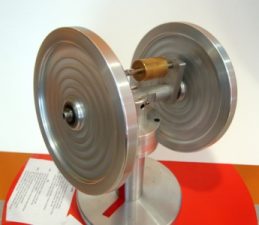
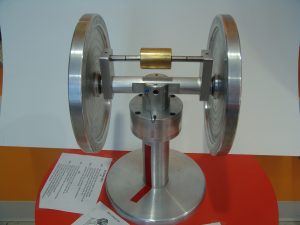
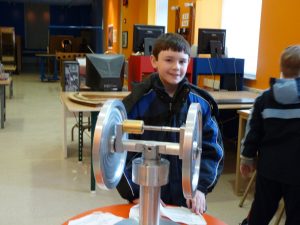
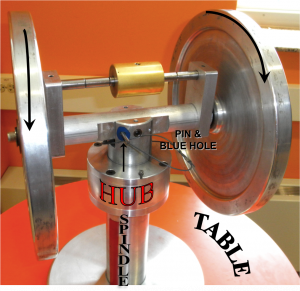
Experiment 1
WHAT TO DO:
- Place the pin in the blue hole.
- Move the brass weight to the center.
- Spin both wheels in the same direction.
- Remove the pin from the blue hole. (Hold onto the spindle if you need to.)
- Twist the hub one direction and then the other.
WHAT HAPPENS WHEN YOU TURN THE HUB?
Answer:
Twisting the hub causes the wheels to drop one side. Changing the direction causes the wheels to drop to the other side.
- Repeat steps 1-4.
- Spin the table under the Gyroscope.
WHAT HAPPENS WHEN YOU SPIN THE TABLE?
Answer:
The Gyroscope doesn’t move!
- Try spinning the table without either of the wheels turning.
The wheels and hub will begin to turn in the same direction as the table this time!
Since the wheels are not spinning, they are not acting as a gyroscope and are much less resistant to small outside forces (like the friction between the table and the spindle).
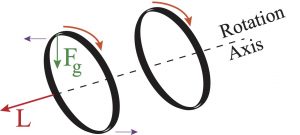
What is going on?
Since the two wheels are rotating in the same direction, their angular momenta, L1 and L2, are in the same direction. (Take a look at the Angular Momentum Turntable exhibit for a good review of angular momentum.) Initially, the system is very stable. When you turn the hub, you are forcing the gyroscope to precess (Experiment 2). This causes a change in angular momentum (torque) which causes the wheels to tip to one side or the other.
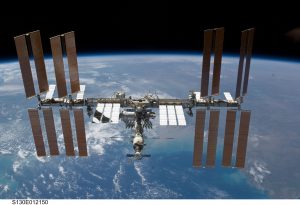
Gyroscopes are used to stabilize motion in space craft (International space station (below) for example), motorcycles, etc. Micro electro-mechanical gyroscopes are used in cell phones, tablet computers, and video game controllers to detect movement and orientation.
Experiment 2
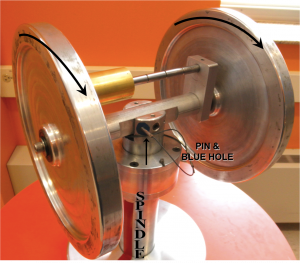
WHAT TO DO:
- Place the pin in the blue hole.
- Move the brass weight to one side.
- Spin both wheels in the same direction.
- Remove the pin from the blue hole. (Hold onto the spindle if you need to.)
WHAT HAPPENS WHEN YOU PULL THE PIN?
Answer:
The wheels begin to turn about the spindle and wobble.
(If you don’t notice any wobble, you can gently tap the bar between the wheels.)
WHAT HAPPENS WHEN YOU MOVE THE WEIGHT TO THE OTHER SIDE OF THE BAR?
Answer:
When the weight moves to the other side, the direction the gyroscope turns changes.
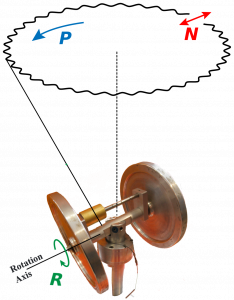
What is going on?
The motion about the spindle is called precession, P. The wobbling motion is called nutation, N.
The brass weight unbalances the gyroscope and causes the rotation axis to tip, changing the angular momentum of the gyroscope. As in Experiment 1, this torque then causes the gyroscope to precess.
Nutation is caused by a small external force applied the gyroscope that unbalances its motion.
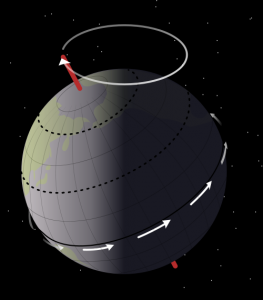
The Earth precesses as it spins on its axis at a rate of ~1° every 72 years. Currently, the North pole points toward the star Polaris (within 1° ), but precession will slowly change the direction that the North pole points in the sky.
The Earth’s nutation changes the relative angle between the Earth and the Sun. This changes how high overhead the sun gets on the Summer and Winter Solstices. The Earth Globe exhibit shows the Tropic of Cancer and Tropic of Capricorn which mark the locations on Earth where the sun will be directly overhead on one of those days. Nutation causes those locations to move by a few arcseconds of latitude each year.
Experiment 3:
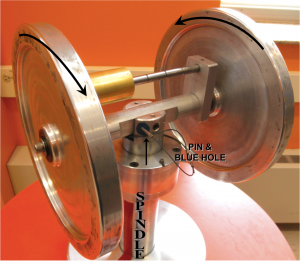
WHAT TO DO:
- Place the pin in the blue hole.
- Move the brass weight to one side.
- Spin the wheels in opposite directions.
- Remove the pin from the blue hole. (Hold onto the spindle if you need to.)
WHAT HAPPENS WHEN YOU MOVE THE WEIGHT TO THE OTHER SIDE OF THE ROD?
Answer:
The wheels flop to whichever side the brass weight is moved toward.

What is going on?
The angular momentum, L, of the two wheels is in opposite directions so they cancel each other out leaving the system with no net angular momentum. The wheels no longer act as a gyroscope and just act as weights.